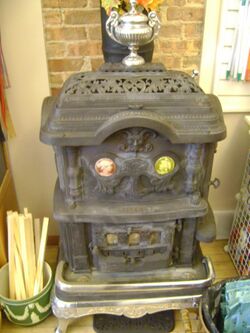Engineering:Red Cross stove
The Red Cross stove is a kitchen or parlor stove used for cooking and heating mainly North American homes of the late 19th and early 20th century. The reason for the name "Red Cross" was because of the advertising logo, which featured a red Gothic cross.
History
The "Red Cross" stove was manufactured in various versions and models from 1867 to 1930 by the Co-Operative Foundry Company of Rochester, New York, United States .[1] This company made a variety of heating stoves and cooking ranges, and had a catalogue that featured a Maltese red cross.[2] They came as wood burners and oil burners.[3][4] It eventually went out of business in 1930. This company that made the "Red Cross" stove was originally organized in 1867 by Nicholas Brayer and Edward W. Peck as the Co-Operative Foundry Company. Frank N. Brayer, father of Nicholas, became its president. Nicholas Brayer was foreman at the John M. French Foundry Company in the mid-19th century where the "Red Cross" stove and other heating stoves were being manufactured originally. That production part of the company branched off on its own and became the Co-Operative Foundry Company.[5] The company prospered at a time when the furnace and stove industry was in flux, with many operations closing or moving — proximity to new sources of demand, costs of transport, and location of raw materials were important factors.[6]
The Co-Operative Foundry Company started with its employees all owning stock in it. When this co-operative was organized, it took over operations of a furnace and stove production plant called the French Foundry and used it as a branch location. In 1920, about $1,250,000 of furnaces, heaters, ranges, and other kinds of stoves, including the "Red Cross" kitchen stove, were being manufactured. Frank M. Brayer, as president, was responsible for producing between 8,000 and 9,000 furnaces in the 1920s. It was estimated that over one million people were being warmed by these heating units that included the "Red Cross" stove.[5]
The plant of the Co-Operative Foundry Company, where the "Red Cross" stove and other ranges were mainly manufactured, consisted of six major buildings and a few smaller ones, with a combined floor area of 300,000 square feet. The prosperous company had the latest technological devices for keeping the manufacturing air clean for the employees and had about 250 people at its peak operation. The company at its Rochester plant in 1920 had a recently installed porcelain enameling plant adjoining the main assembling plant. The enameling capability could then produce fifty "Red Cross" stoves a day. The concrete structure plant producing the "Red Cross" stove contained 7200 square feet of floor space. This "Red Cross" stove production branch had its own electric power plant equipped with a 450- horsepower Kerr turbine. In 1909, the full line of "Red Cross" enameled stoves had its own special 76-page color catalog to illustrate the models and colors available.[7] The colors were grey, blue, green, and black. There was a prosperous European business for the "Red Cross" stove headquartered in the Netherlands.[5]
Also, another branch of the company in Chicago, started in 1879, marketed "Red Cross" stoves. This branch was run by Robert Robinson under the name R. Robinson and Son located on Lake St. The company changed its name in 1890 to Robinson Furnace Company when they added warm air heaters.[8] The Red Cross parlor stove won a prize metal at the 1873 Vienna World's Fair in Vienna, Austria.[9]
References
- ↑ Shilling 2005, p. 54.
- ↑ Williams, David (1896). "Odd Plates". The Metal Worker 45: 51. https://www.google.com/books/edition/The_Metal_Worker/To5CAQAAMAAJ?hl=en&gbpv=1&bsq=%20%22Maltese%20red%20cross%22. Retrieved May 8, 2020.
- ↑ "Red Cross Stove antique cast iron wood burning stove". eBay. 2020. https://www.ebay.com/itm/RED-CROSS-STOVE-antique-cast-iron-wood-burning-stove-/323711991273.
- ↑ "Red Cross Oil Stoves". The Evening Sun (Hanover, Pennsylvania): p. 5. 8 June 1926. https://www.newspapers.com/clip/50739116/.
- ↑ 5.0 5.1 5.2 Engineering Publications, p. 92
- ↑ "The Stove Industry in 1892". National Association of Stove Manufacturers. 1892. https://docs.google.com/viewer?a=v&q=cache:1je_bd-52KYJ:www.dur.ac.uk/h.j.harris/stoves/stove_industry_1892.DOC+co-operative+foundry+company&hl=en&gl=us&pid=bl&srcid=ADGEESgtxyqz0F6_SaFful8at9A6v3Cw-Oau4w1xuIQh1iiRc5KqTXFCx1VnPy-3VWFcMXkp1-PU3VlOcrNvAg7l0_aRnlDQLG3BGi8DgknhlNPXJBT1wWVAZ-rsg8eys8OLlefQTj38&sig=AHIEtbR5iwAt6ZYew7LWlfUqgveJHDGoZA.
- ↑ "Stove and furnace trade". The Metal Worker, Plumber and Steam Fitter (New York) 72, Part 1: 64. 21 August 1909. https://books.google.com/books?id=0qovAAAAYAAJ&dq=Red+cross+stove+catalogue&pg=RA4-PA64. Retrieved 3 December 2011.
- ↑ Stern 1920, p. 25.
- ↑ "Myers & Yarnell". The Somerset Press (Somerset, Ohio): p. 1. 3 November 1876. https://www.newspapers.com/clip/50667250/.
Sources
- Stern, Daniel (1920). American artisan: residential air conditioning, warm air heating, sheet metal contracting. 80 Part 2. Engineering Publications,Inc. https://books.google.com/books?id=o9hKAQAAIAAJ.
- Sanitary and heating age. Original from the University of Michigan: Sanitary and Heating Publishing. 1895.
- Shilling, Donovan A. (2005). Rochester's leaders and their legacies. Charleston, SC: Arcadia publishing. ISBN 0-7385-3835-3.



